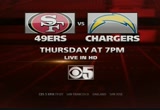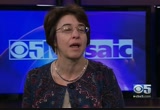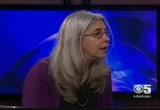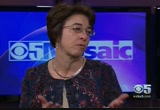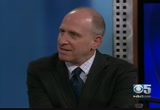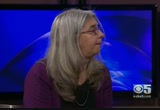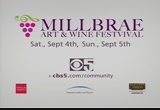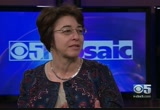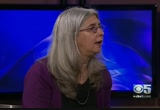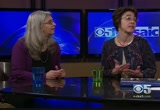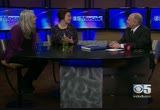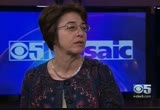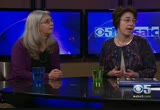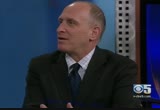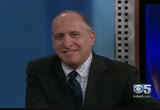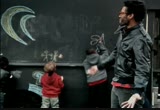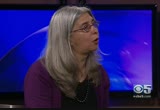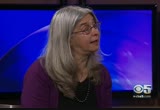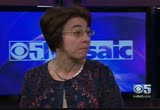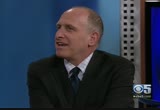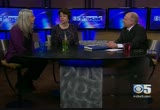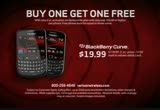tv Mosaic CBS August 29, 2010 4:00am-4:30am PST
5:00 am
welcome to mosaic. i am rabbi eric wise and honored to be your host. we are about to start a conversation on a fascinating new topic, jews on the pacific coast. reinventing community on america's edge. joining us are two of the three authors. ava k ahn, author on many books on the topic and professor ellen ellenizeen burg. welcome. >> thank you. >> this is a wonderful book seems a tremendous edition to
5:01 am
the way we frame jews on the pacific coast what was your intent in writing this book? >> sure. well, the field of american jewish history has been so traditionally framed by the east coast. particularly new york. one of the things we wanted to do with this book was to reorient that in some way and demonstrate the importance of the communities here and also demonstrate they are not just some sort of shadow of the eastern experience but a unique experience here really distinctive in some ways of what happened back east. >> what is distinctive about the jewish immigration experience to the pacific coast? >> well, it is people who wanted to take a chance. they tended to be step migrants, therefore they stopped in the eastern u.s., or midwest, probably, before they came to the west, who by the time they got here, they were
5:02 am
fairly well americanized, they weren't really needed to sit in an immigrant community but could work with everybody, and ready to have experience to build their own community structures. >> you use the term step migrants. >> meaning they stopped along the way. they might have come from europe, and then lived in new york, maybe chicago, maybe in the dakotas, before they made their way or if they were coming the other direction, my pet topic is that they came from england to australia or new zealand then came west but these were people who had experience building other jewish communities. >> i was going to say in addition, when they got here, at least those who came early on, there wasn't a pre-existing
5:03 am
hierarchy or structure they got in on the ground floor and because many of them were merchants they moved into communities where others were miners or farmers depending on where in the west we are talking about and those people, needed places to buy and sell goods so they became kind of a center piece of a huge number of small towns up and down the west coast. and performing a really essential function. they really got in on the ground floor, came civically and entrepreneurially, prominent quickly. >> so different from the east they were the founders of these communities rather than interlopers on a community that was already established. >> how i do mean that? >> the ones born in the u.s., as citizens or became citizens soon after, they could run for office, they could be often on the first city councils of a
5:04 am
town and become a mayor very easily of the city where in the east you had already an established culture and so you have sort of new comers, versus immigrants. where in the west everybody is the same. so it is more an equality and more a sense of ownership in your city, because you helped found it, you helped put the civic government together. >> fascinating. what is really amazing about this book as you point out, how immigrants didn't just come to what at that time is considered urban centers like san francisco or like los angeles,. >> well, los angeles wasn't an urban center. >> but people ended up in places like marysville california, places like salem oregon, people ended up in lots of places you wouldn't even today think that jews even went to, to begin with. >> san francisco was the hub
5:05 am
and everybody came in through san francisco because it is of course a major port but economies drove people all over marysville was a major town because it was on the river. and that was how transportation was handled in the mid-19th century, and you had all the little gold camps around marysville so all goods in and out of those gold camps went through marysville so marysville was actually a very important community. >> very frequently there were networks of families, someone might come west and start out in a smaller town and move up and then merchants who had made it, so to speak, very often they had networks of brothers, nephews and so on in smaller communities and often they would even have one back east so they established these trade networks of their own and stand out. kind of across the landscape. >> when a new nephew came west,
5:06 am
5:07 am
5:08 am
american jewish experience in the past has concentrated on jews with came to the eastern sea board and maybe the west in some ways to the south, but what took us all so long to sort of focus in the more academic manner, with books such as this on the jews of the pacific coast on the west? >> well, i think the major universities and where the jewish historians were, were in the east, and you tend to write about what you know and of course, the population centers were in the east. that is where a lot of people got off the boat so you feel sort of that's the story. and people are like us, starting to say no, hey, we are here too. you know. >> it is interesting if you look at some of the community histories, histories of places like seattle or portland or so
5:09 am
on, a lot of the local historians will talk about how the immigrant neighbourhood was reminiscent of the lower east side, you know, there has been so much focus on that lower east side experience, as this iconic image of american jewish history, it tended to be maybe over generalized and people identify with that story, that is the story told of american jews collectively but it has taken awhile to convince people there are other stories that are also important. >> in some way it seems this is a kind of our own maturation process to say not just that we are worried of our own self- reflection but certainly historic significance of this and different jewish immigration experiences in the united states. >> well, i grew up in l.a. i will admit that. for me when i started studying jewish history and heard about
5:10 am
the new york experience it seemed completely foreign to me. my relatives were from chicago. i had no relatives, one or two in new york and this whole ideal of that being where you had to be jewish, where history was seemed ridiculous. i grew in a community that was very jewish and i knew there had been jewish list we when i became a historian and started looking at san francisco and the gold rush and the people that came and the importance of the jewish community, i was sort of how come i can't find this in books. there needs -- you know, i think the three of us when bill, alan and i started working on this book, we felt there was just a need that three of us had to come together and tell this narrative that had not been told before. >> we should say william tolder
5:11 am
wasn't able to be us with this morning as professor of american jewish history you versety of oregon. >> correct >> -- university of oregon. >> correct. >> this three of us were always placed together on a panel because we were all doing some paper on some aspect of western jews and after awhile, it is one of those we went out after one of these panels and said some body should pull all of this together in a book, there should be a book that define it is western jewish experience in a way that is accessible to the general public, that is where this book started more years ago than i care to say. >> it is a face nateing book something really academic not just a popular book and also not just a cocktail book for entertainment, it is an astonishing amount of information and moves the conversation forward in a significant way. we will return to mosaic in just a moment please come back and join us in just a moment
5:14 am
welcome back to mosaic i am crabby eric ice. we are joined by ava -- wise, we are joined by avakahn and ellen talking about jews of the pacific coast, reinventing community on america's edge. what are some themes that you especially like and put into this book with the context to have american jewish experience on the west coast? >> do you want to talk about interexecutiveness? >> sure there are a number of themes that we try to emphasize here. one of them is the executiveness of all of these communities in the west until ava was speaking before about the san francisco hub 13 connections between the merchant -- and connections
5:15 am
between the merchants and cities that happens at a communal level too. this is interesting to trace, look at papers of those who live in these very dispersed communitythe way they kept in touch with what is going on in san francisco, subscribed to the paper, a regional paper, and they -- if they had questions of kind of jew dayic ritual and so on, they would send them. >> where they would come to san francisco to find wives for example when the time came to marry. there was a strong executiveness among these communitysome of them are almost dotter communities of the other. ava mentioned last night emanuel in victoria,. >> british columbia. >> is a dotter congregation of emanuel here in san francisco. >> there are a lot like that where the founders originally were from san francisco and
5:16 am
they moved but then of course the crabby of emanuel -- the rabbi of emanuel came to portland when congregation was holding opening ceremonies and such, because that is how close they felt the rabbi was willing to take a boat -- a long boat trip at this point from san francisco up to portland. >> you see that through into the 20th century, in terms of almost the market for jewish professionals, are bin call leadership and so on is a west coast market. people will move from a pulpit in tacoma to one in oakland. >> very much a circuit. >> among them. >> and the institutions were also regional. pacific hebrew orphans asylum was founded in san francisco but children as far away as seattle and los angeles were sent there and taken care of there, and then when a jewish hospital was founded in mount zion in san francisco, it was
5:17 am
seen as a regional hospital. then later when the city of hope was founded in los angeles, for tb victims, they raised money, had support groups all throughout the west. >> one of the interesting things i think is connected to that interexecutiveness is the sense of regional identity that emerged. they were not just locally identified but regionally identified with the west in a positive way. we make a contrast with southern jews, there has been an active scholarship in southern jewish history in recent years they talk about the kind of tension in southern jewish identity there is a tension with being southern and jewish and that here in the west that seems quite the contrary that the two seem mutually reinforcing, they don't feel a conflict between the two in the same way.
5:18 am
>> when the -- both the city of hope and pacific hebrew orphan asylum were founded they said they wanted to be known as giving benefit not only to the city but pride to the region. s to pacific region they have that in their constitution. >> is that an indication how when jews came to the west there wasn't already established leadership as there was in the east coast. not an x versus y they were themselves the leaders of the community and so they were able to in many ways define shape and really establish their own presence in that way. >> yes, and there was also the idea that some saw the west as the promised land, all the biblical imagery, well, as one of the photographs in the book is moses coming down from hills of yosemite, earl capitain --
5:19 am
>> same in san francisco. >> right the idea of receiving the 10 commandments in yosemite valley and marching to san francisco, the new promised city, whole identification with the nature of the west not just sort of being a place where you are going to stay for awhile until you can move on. >> fascinating. we will take a break and return here to mosaic in just a moment. please join us ♪ ♪ ♪ [ female announcer ] within every pillsbury package is the power to enrich a child's mind. collect pillsbury double box tops
5:20 am
for education today. to bring art to the people. i strongly believe that there is art in every single person. sharing art is the highest calling for me. but without my health i wouldn't be able to do anything. [ male announcer ] to keep doing what you love, keep your heart healthy. cheerios can help. the whole grain oats can help lower cholesterol. this is what makes me happy, so i'll probably do this until the wheels fall off. [ male announcer ] it's simple, love your heart so you can do what you love. what do you love? see how cheerios can help you do it.
5:21 am
field trips to the zoo! more basketballs. soccer balls. and a museum! [ growls ] more basketballs. soccer balls! more books. yeah. like just a ton of books. [ girl ] and books about soft things. soft and slimy. [ female announcer ] now clip double box tops for education. from totino's pizza rolls and party pizzas. and make their school a better place. welcome back to mosaic. i ap rabbi eric wise we are joined by ava kahn a local historian, author and expert on jewish life in california and professor ellen from oregon.
5:22 am
the book you've written has wonderful stories of individuals that really identify lots of things we have talked about what are some story that is linger with you as the authors? >> well, the one i love to share is about the goldsmith family. isaac goldsmith came in the early 1850s to san francisco, with his wife and his children, he came from -- first from poland then to new york then they got on a boat and went down to nicaragua, they crossed the isthmus of nicaragua, walking on mules in a canoe, his daughter mary was 5 then and put on a mule to come across they came to san francisco and he became one of the first shokuts of the
5:23 am
community. there were kosher butchers in the 1850s. then his daughter became marry goldsmith plague who ran for school board this 5-year-old grew up, taught at lowell high and girls high she became -- served on the school board and her daughter became the first jewish congress woman in the united states in 1924. >> representing. >> san francisco. >> wow. >> so therefore. >> the first jewish congress woman in the united states was from san francisco and was the granddaughter of a shokut who came by way of nicaragua. >> that is a ritual slaughterer in jewish condition to render -- one of the steps in rendering meat kosher. >> right >> one of my face-to-face rivers is noodle man family, --
5:24 am
favorites is noodle man family. joseph noodleman lived in russia in 1880. he decided the solution was to establish colonies. there was a group that came here to the united states to establish colonies. so he came with a group of people many were relatives but friends as well they went into new york, colorado where they tried to earn money for a settlement, he worked on the railroads, became part of a settlement in north dakota, lasted there several years and was sort of an itinerant jewish settler tried farming in california, ranches in nevada and he and many other former north dakota colonists wound up in portland oregon where they all opened shops one next to the other and he became a leader in orthodox jewish community in portland his story interests me i have a long
5:25 am
standing interest in agricultural colonies but the way he came across so gradually, skills he accumulated as he came by the time he settled in portland he had the quintisential western experience, and knows how certainly he knows how to speak english, served on school board in north a dakota. kind of assembled a tool kit of skills that really enabled him to become a community leader in portland. >> so fascinating. it occurs to me you are a social historian and these marvelous books are only written because people leave material behind, for people such as ava and yourself and william told to read together. as a social historian what are somethings that people that come after you should be thinking about now to save for
5:26 am
the future? >> everything. it is amazing -- i mean people always think of the papers of the famous person or important community leader, sermons of the prominent rabbi and of course those are important but in working on the book we use programs, from individual synagogue events, to get a sense of what was important to that synagogue when they celebrated their 25th anniversary in 1922 or something what was important to them who were the speakers, the mayor came to speak that is interesting for us to know. that tells us something about that community. >> or papers of more ordinary immigrants who came and founded a small store maybe the ones who weren't so successful. >> the diaries are very important but also oral histories. we used a lot of oral histories because the oral histories you can almost go back to the gold rush not that people recorded then but their grandchildren were.
5:27 am
what are the reposes tours of this kind of material, to give your papers to? >> the western jewish history center at the magdas museum has a fantastic collection. that is moving to the ban i don't have the library. >> at uc berkeley. >> wonderful we just have one moment even left so before we end let's let people know where they can get this book. >> you can speak to that locally. >> ah, well, i think it is available at least to order at most local bookstores. >> and publisher. >> or online book sellers. >> amazon and the publisher is? >> university of washington press. >> jews of the pacific coast, reinventing community on the edge. have a wonderful day thank you for joining us here on mosaic
5:28 am
mmmm. you don't love me anymore do you billy? what? i didn't buy this cereal to sweet talk your taste buds it's for my heart health. so i can't have any? if you can deprive me of what can help lower my cholesterol... and live with yourself. right. mmm, i worry about your mother. cry herself to sleep every night over my arteries, but have yourself a bowl. good speech dad. [ whimper ] [ male announcer ] honey nut cheerios tastes great and its whole grain oats can help lower cholesterol.
5:29 am
226 Views
IN COLLECTIONS
KPIX (CBS) Television Archive
Television Archive  Television Archive News Search Service
Television Archive News Search Service 
Uploaded by TV Archive on

 Live Music Archive
Live Music Archive Librivox Free Audio
Librivox Free Audio Metropolitan Museum
Metropolitan Museum Cleveland Museum of Art
Cleveland Museum of Art Internet Arcade
Internet Arcade Console Living Room
Console Living Room Books to Borrow
Books to Borrow Open Library
Open Library TV News
TV News Understanding 9/11
Understanding 9/11